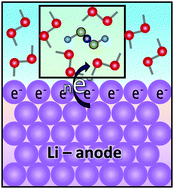Elucidating electrolyte decomposition under electron-rich environments at the lithium-metal anode†
Abstract
The lithium metal anode is one of the key components of the lithium–sulfur (Li–S) batteries, which are considered one of the most promising candidates for the next generation of battery systems. However, one of the main challenges that have prevented Li-metal anodes from becoming feasible to be used in commercial batteries is the continuous decomposition of the electrolyte due to its high reactivity, which leads to the formation of solid–electrolyte interphase (SEI) layers. The properties of the SEI can dramatically affect the performance of the batteries. Thus, a rigorous understanding of the electrolyte decomposition is crucial to elucidate improvements in performance of the Li–S technology. In this work, using density functional theory (DFT) and ab initio molecular dynamics simulations (AIMD), we investigate the effect of electron-rich environments on the decomposition mechanism of electrolyte species in pure 1,2-dimethoxyethane (DME) solvent and 1 M lithium bis(trifluoromethanesulfonyl)imide (LiTFSI) and lithium bis(fluorosulfonyl)imide (LiFSI) salt solutions. It is found that systems with pure DME require an average environment of at least ∼0.9 |e| per molecule for a DME to decompose into CH3O− and C2H42−via a 4-electron transfer. In the case of mixtures, the salts are very prone to react with any excess of electrons. In addition, DME dehydrogenation due to reactions with fragments coming from the salt decompositions was detected. Formation of oligomer anionic species from DME and salt fragments were also identified from the AIMD simulations. Finally, the thermodynamics and kinetics of the most relevant electrolyte decomposition reactions were characterized. DME decomposition reactions predicted from the AIMD simulations were found to be thermodynamically favorable under exposure to Li atoms and/or by reactions with salt fragments. In most cases, these reactions were shown to have low to moderate activation barriers.



 Please wait while we load your content...
Please wait while we load your content...